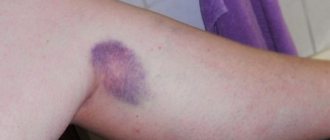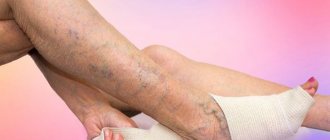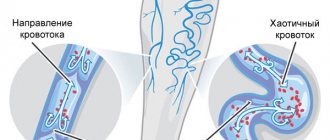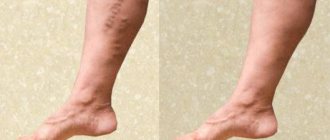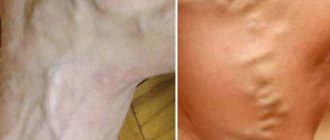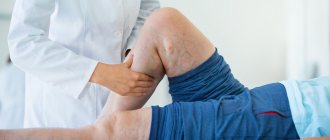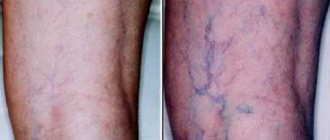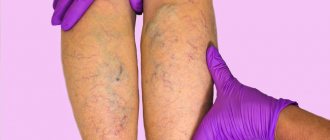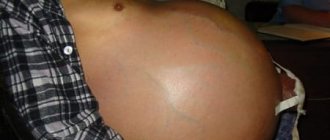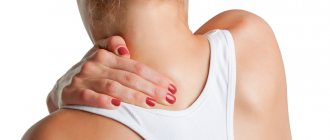For a long time, many people may not even be aware of the problems that exist in the body, but have not yet manifested themselves sufficiently. For example, the most common situation is the appearance of a peculiar pattern in the form of a vascular network on the lower extremities. Vessels in the legs burst more often in women, although a similar phenomenon also occurs in the stronger sex. But men usually simply do not attach importance to unpleasant spots, while for women they turn into a real aesthetic problem.
You need to perceive the situation correctly
It is known that before taking on a solution to a problem, it is necessary to understand it. In most cases, the culprit for the appearance of bruises and spider veins is varicose veins. For a long time it can proceed hidden and not cause much discomfort. A person begins to worry only when bruises appear on his legs. This sign means that the vessel has burst in this particular place. Vascular injury can occur anywhere in the lower extremity.
Important point! The regular appearance of hematomas (bruises) should be a serious argument for visiting a medical facility. You especially shouldn’t put off visiting a doctor when such symptoms are accompanied by pain and swelling in the affected area.
Why are varicose veins dangerous?
This disease develops against the background of poor circulation in the legs. Due to the malfunction of the venous valves, which are supposed to direct blood flow back to the heart, blood stagnates. As a result, pressure increases in the vessels of the legs , the walls gradually become thinner and sooner or later break.
Rupture of veins leads to:
- sepsis;
- gangrene;
- thrombosis;
- trophic ulcers;
- open bleeding.
At the same time, with open bleeding, pain may not be felt, so a person sometimes notices the injury when the blood has already flowed into the shoes. The main signs of varicose veins are:
Most often, women experience varicose veins due to hormonal changes in the body with age or during pregnancy. For these reasons, it is especially important for women to monitor the health of their feet and undergo periodic examinations by a specialist.
What else leads to varicose veins:
- work “on your feet”;
- clothes that are too tight;
- high heels;
- alcoholism;
- genetics;
- obesity;
- lack of vitamin C;
- injuries;
- frostbite.
If symptoms of varicose veins are detected, you must consult a phlebologist and begin treatment at an early stage.
Under what conditions does vascular damage occur?
The skin is nourished by small vessels - capillaries, and larger veins and arteries are located in the tissues. The cause of any type of hemorrhage in most cases is injury, which can develop through one of the following mechanisms:
- direct rupture of the vessel,
- coagulopathy (blood clotting disorder),
- thrombocytopenia (deficiency of platelets in the blood),
- increased permeability of vessel walls.
When the integrity of the vessel is broken, blood enters the subcutaneous space. It actively permeates soft tissues, causing bruises to form on the skin.
What are varicose veins
Varicose veins are a disease in which venous vessels undergo pathological changes.
As a result of violations, the veins expand, stretch, become deformed and form nodes.
In the initial stages, the patient does not notice visual changes. You only feel tired and heavy in your legs, which is attributed to fatigue after a day of work.
The main symptom of varicose veins is a bulging, bluish vein on the surface of the skin , which indicates an already developed disease.
The mechanism of development of varicose veins
Reference. All these changes are painful and exhausting, because they cause disruptions in blood circulation and entail a lot of unpleasant complications.
All these changes are a consequence of dysfunction of the venous valve system . When functioning normally, the valves promote normal (upward) circulation of venous blood. A failure in this system leads to the fact that blood begins to flow downward, forming stagnation.
The vessels are unable to cope with such pressure and begin to deform, giving the patient a lot of unpleasant painful sensations.
The reasons for this phenomenon can be both a hereditary predisposition and an unhealthy lifestyle.
Reference. You can learn more about the causes, symptoms and features of the development of the pathology here.
Most often, varicose veins affect the lower extremities , but hemorrhoids, esophageal varices, varicoceles and pelvic varices are also common.
It is also worth noting that women are more susceptible to the disease than men due to the characteristics of the processes occurring in the body.
Why do blood vessels get damaged?
Endogenous factors
There are quite a few reasons for the fragility of blood vessels, so in medicine they are usually divided into external and internal factors. Among the endogenous reasons:
- high levels of insulin, which often causes almost black hematomas,
- low hemoglobin,
- leukemia, as well as other oncological pathologies,
- gynecological diseases in women,
- HIV infection,
- autoimmune conditions (lupus erythematosus),
- hypertension and VSD (vegetative-vascular dystonia),
- coronary disorders,
- some types of vitamin deficiencies (PP, B 12, folic acid and C),
- taking antiplatelet drugs (blood thinning drugs),
- hereditary predisposition,
- obesity at any stage (excess weight is an additional load on the blood vessels),
- metabolic disorders caused by poor nutrition,
- inflammatory processes (meningitis, sepsis, tonsillitis),
- allergic manifestations,
- side effects from drug treatment (chemotherapy drugs, hypothiazide, sulfonamides and others).
Exogenous factors
In addition to internal conditions, there are also external reasons that can also have a negative impact on the structure of blood vessels. Among the exogenous provocateurs:
- prolonged exposure to ultraviolet and other types of radiation,
- various injuries (bruises, frostbite, burns),
- excessive physical activity,
- stressful conditions,
- cosmetic procedures (peeling),
- physical inactivity (sedentary lifestyle)
- Smoking negatively affects the functioning of the entire circulatory system, and the habit is especially harmful for the strength of the vascular walls.
Good to know! The natural aging process often leads to fragility of blood vessels, then hematomas appear on the arms, legs and other parts of the body.
How to treat the problem
The appearance of bruises for no external reason is the first signal of an impending problem. Even if the burst vessel left a small mark, the situation should be studied by a specialist.
Pathology can be localized at the very beginning through non-drug methods - exercises, massage, lifestyle changes.
What to do first
If a blood vessel bursts on the leg for the first time and a person discovers a small bruise, the best solution would be to consult a doctor.
In this case, you can limit yourself to the following recommendations:
- Refuse to wear uncomfortable shoes - narrow, high-heeled, inappropriate in size.
- Adjust your diet. The menu should include a large amount of vegetables, fruits, meat and low-fat fish. It is suggested to avoid eating fatty foods with a lot of salt.
- Monitor blood pressure.
- Take vitamin and mineral complexes.
Simple gymnastics
The easiest way to organize blood flow in the vessels of the lower extremities is with the help of special gymnastics. The exercises consist of performing vibration movements with the lower limbs.
There are other useful exercises:
- Take a sitting position on a chair with your feet together. Leaning on your heels, make return movements with your fingers.
- The starting position is the same, legs are extended forward, toes are pulled towards the person.
- Sitting on a chair, raise your legs one by one and hold them at the top point for a few seconds.
- Roll a small ball with your foot.
The listed complex is easy to implement even at work.
Other techniques
To avoid a situation where a blood vessel bursts, you can go for short runs or visit the pool. All this helps to maintain the components of the vascular system in good shape, eliminating the likelihood of developing a stagnant process.
The pain syndrome that begins to develop can be relieved with massage. It is optimal for it to be carried out by an experienced master.
A contrast shower is another way to eliminate developing pathology. Using water massage has a positive effect on the condition of the skin and reduces the fragility of blood vessels.
Methods of official medicine
When a person notices that not only a blood vessel has burst, but also small subcutaneous hematomas have begun to develop, and a feeling of heaviness in the legs appears, it is necessary to consult a doctor.
After a detailed examination, a specialist may recommend wearing special compression stockings and tights. Special weaving keeps muscles and blood vessels in good shape. This eliminates the possibility of developing stagnant processes.
Hardware methods
The following hardware methods are used in clinics:
- Microsclerotherapy. A special solution, a sclerosant, is injected into the superficial veins. This substance glues the damaged vessel together. The remains are completely absorbed by the body within 21 days. The duration of one procedure is from half an hour. How many times the solution will need to be administered is decided solely by a specialist, based on the results of the examination and medical history.
- Laser therapy. The laser beam strengthens the blood element hemoglobin. As a result of the procedure, the damaged vessel is restored, and the bruise completely resolves. Women with particularly sensitive skin or insufficiently trained specialists may experience scars, burns and bruises.
- Elos coagulation. A new word in aesthetic medicine. The procedure is based on the positive properties of bipolar electric current, laser energy and/or light.
Important! However, even if one of the listed procedures is successful, it is impossible to guarantee that the pathology will completely disappear.
In addition to hardware methods of treatment, doctors often prescribe ointments, the use of which is accompanied by taking medications orally.
During pregnancy
A separate case is the period of pregnancy in women. The body of the expectant mother experiences enormous stress: organs and systems are rebuilt, hormonal levels change. It is during this period that varicose veins are most often first detected in women.
Related factors play a huge role here:
- hemorrhagic diathesis, in which the smallest vessels burst,
- hereditary thrombophilia is a phenomenon accompanied by the appearance of hematomas for no apparent reason,
- some types of anemia can cause vascular damage,
- liver failure,
- taking certain medications.
Helpful information! Women carrying children must adhere to a diet, eat well and wear special underwear. These simple measures will help strengthen blood vessels and prevent further development of varicose veins.
Principles of therapy
There are many ways to eliminate a burst vein. The most common method is microsclerotherapy. The essence of the procedure is the introduction of sclerosant into the subcutaneous layer.
Modern cosmetology offers another innovative method - elos-coagulation. The procedure uses high-frequency biological electric current and laser energy. With their help, the affected vessels are removed.
In some cases, a special laser is used to remove the consequences of pathology. It affects hemoglobin, in which energy begins to accumulate and is transferred to the walls of blood vessels. Despite their high effectiveness, these methods do not guarantee the absence of relapse.
You can do special therapeutic exercises at home. They are used to strengthen blood vessels and are performed in a horizontal position on the back. In this case, the lower limbs should be raised up and move throughout the entire time, so that the main load falls on the lower back and hips. But the best method of therapy is to eliminate provoking factors.
Characteristic symptoms
When a vessel is damaged, a hematoma forms almost immediately. A bruise can range in size from a few millimeters to tens of centimeters. In other cases, the spots occupy an impressive area, sometimes they merge, forming one huge hematoma. The formation can persist for several weeks, gradually changing color, and then disappearing without a trace.
Based on the type of hemorrhage, you can determine which vessel’s integrity is compromised:
- Telangiectasia is a network of dilated small capillaries. Such vessels usually do not burst. This phenomenon is in the nature of a pronounced cosmetic defect. Most often, telangiectasias appear against the background of existing varicose veins.
- Purpura is the accumulation of some blood under the skin. The formation has the appearance of a smooth, shiny spot.
- Ecchymosis is a large bruise caused by trauma.
- Petechiae is a pattern in the form of pinpoint hemorrhages, which is formed by burst capillaries on the surface of the skin.
Important point! If the hemorrhage is not the result of an injury, you should immediately visit a doctor.
Characteristic manifestations
The main symptom that quickly occurs after the integrity of the vessel is damaged is bruising (hematoma). Its size can range from 1-2 mm to 50 or more centimeters. It depends on which tubular formation (large or small) is damaged. In case of severe injuries (accidents, falls), several veins or sections of them may burst, then most of the limb is covered with bruises. Separate bruises merge into one hematoma.
The formation first has a red-violet color, then it becomes brown, yellow-green. The hematoma, painful to the touch, stays on the leg from 8-10 days to 3-4 weeks. Gradually the bruise turns yellow, turns pale, and then disappears without a trace.
There are several types of hemorrhages, which can be used to judge which vessels have burst. For example, when deep veins are injured, ecchymosis appears - extensive bruising. When the superficial tubular structures are damaged, collections of blood (spots) called purpura form under the skin. The skin over them has a smooth, shiny surface.
If the capillaries burst, a pattern appears under the skin formed by pinpoint hemorrhages - petechiae.
Some people confuse them with telangiectasia - networks of dilated but intact small vessels that appear with varicose veins.
Important information: Why there is heavy bleeding in the middle of the menstrual cycle (after menstruation) in women and how to stop bleeding from the vagina
Another sign of vascular damage is pain, sharp when damaged, and then aching when touching the bruise or when walking. When large veins burst, the victim loses the ability to walk for several days.
With severe blood loss, a person’s skin becomes pale, he becomes dizzy, chills and severe weakness appear.
Features of the flow
A specialist in the size and nature of the pattern will be able to determine which vessel is damaged: the larger the area of hemorrhage and the more distinct the pattern, the larger the burst vessel. The cause can also be established immediately, or at least assumed. Thus, a bruise at the site of the injury always causes pain upon palpation. As noted above, burst capillaries often appear on the skin surface in the form of a mesh pattern. Such meshes are often shown in photos of popular cosmetology websites.
Such designs have completely different shapes: they often resemble stars, tree branches, or intricate patterns. When large arteries and veins are damaged, a huge hematoma is formed. If the integrity of the internal vessels is compromised, then large blood loss cannot be ruled out, which is a threat to human life. As a rule, hemorrhage is accompanied by the following symptoms:
- pain at the site of vessel damage,
- general weakness,
- chills,
- pale skin,
In medical practice, there are cases when a hematoma bursts and its contents flow out. If the capillaries are damaged, this phenomenon can be easily stopped and does not require serious measures. But, if even a small vein bursts, you cannot do without emergency measures in such a situation, because severe bleeding can result in death.
Helpful advice! The capabilities of modern medicine make it possible to accurately determine the cause of fragile blood vessels at the initial stage of the disease, which helps to promptly block the further development of the pathological process.
How to treat
In case of injury or vascular disease, you should consult a phlebologist.
Most often, to treat injured veins, surgery is prescribed, after which therapy is carried out aimed at strengthening the blood vessels.
Surgery in the event of a burst vein cannot be avoided. Such treatment is primarily necessary to remove the damaged section of the vein.
At the earliest stages, when varicose veins manifest themselves only in spider veins and small bruises on the legs, sclerotherapy and phototherapy are used. Such services are provided by beauty salons, but for your own peace of mind it is best to undergo treatment in a professional medical clinic.
One of the newest methods for removing spider veins is elos coagulation. In this case, damaged capillaries are removed using a laser and high-frequency electric current. The procedure is painful, has contraindications, but is quite effective.
How to determine the nature of the lesion
Before planning treatment measures, it is necessary to accurately determine the type of hemorrhage. There are several simple tests that can quickly identify the cause of the damage.
- Pinch method. In the subclavian area, you need to use your fingers to gather a small area of skin into a fold, then lightly squeeze it and turn it. In the absence of vascular pathologies, a bruise does not form at the site of manipulation. If after the test a hematoma remains, it means the vessels are fragile.
- Hammer method. If after lightly tapping the chest with a percussion hammer a bruise appears, it can be judged that the blood vessels at the site of impact have burst.
- Tourniquet method. Testing is carried out using a rubber band or a tonometer cuff. The device must be placed on the middle of the shoulder and tightened. High fragility of blood vessels will be indicated by traces of pinpoint hemorrhages that appear after a five-minute test.
Conclusion. If the result of all three tests is positive, a person must undergo a full range of diagnostic procedures, because at any moment his capillaries or larger vessels may burst.
Important! The frequent appearance of petechiae, purpura, and bruises on the body should be regarded as a serious problem.
Carrying out diagnostics and treatment
If bruising occurs for no apparent reason, you should contact a medical facility for diagnostic testing and prescribing a timely and adequate course of treatment.
When contacting a doctor, he must do an initial interview and examination of the patient; after carrying out the initial diagnostic procedures, the doctor receiving the patient directs him to conduct an examination of the body. During the examination, laboratory and instrumental diagnostic methods are used.
In any case, ruptures of blood vessels, which result in the formation of a bruise or hematoma, indicate that complex treatment is necessary, which requires immediate consultation with a doctor who treats the vascular system.
When you first visit a dermatologist, you should be prepared for a number of questions:
- whether the damaged areas swell;
- when exactly did the first burst capillary or vessel appear;
- a burst vessel that formed a bruise appeared during a mechanical injury;
- whether there was a visit to a beauty salon the day before;
- whether there are blood relatives with pathologies in the development of the vascular system, for example, such as varicose veins or chronic venous insufficiency;
- does a burst blood vessel cause pain?
Urgent Care
In some situations, a burst vessel in the leg requires emergency measures. First aid can be provided by the victim himself or any third party. The algorithm of actions is as follows:
- A tight bandage should be applied to the area where a large hematoma has formed under the skin.
- The victim must take a horizontal position. At the same time, his injured limb is raised above the level of his head and fixed.
- Cold is applied to the site of the hemorrhage for a quarter of an hour.
- If the bleeding cannot be stopped using the listed methods, you must definitely call an ambulance.
Special instructions! The following symptoms cannot be avoided without qualified medical care:
- if a node has formed at the site of damage to the vessel, or the skin has become very dark,
- when hemorrhage is accompanied by swelling of the leg,
- with intense nasal, intestinal bleeding and damage to the vessels of the urethra.
Clinical picture
If a vein in the leg bursts, a bruise quickly forms in the affected area, the size of which can vary from the most insignificant (a few millimeters) to a large bruise, the diameter of a human palm. We know that the most common cause of hematoma formation is increased mechanical impact on any part of the lower limb. And if the accumulation of blood occurs without traumatic intervention, then qualified specialists recommend immediately contacting the nearest medical facility in order to identify the true cause of the burst vessel on the leg and promptly prevent the development of all kinds of complications.
Minor pathology can disappear on its own after a couple of days. Therefore, if the self-regeneration procedure does not occur for quite a long time, it is also recommended to visit an experienced specialist who will advise you on this matter. Very often, if a vessel on the leg bursts, this means that this phenomenon is only a sign of the presence of an unnatural pathology in the human body, requiring immediate medical intervention.
Mostly there is excessive darkening of the injured soft tissues
There are also accompanying symptoms that indicate that a serious disease is progressing in the human body, which significantly worsens the victim’s quality of life:
- sudden appearance of intense pain at the site of damage to the vascular walls;
- the formation of unnatural compactions in the affected area;
- excessive darkening of injured soft tissues;
- formation of swelling in the lower extremities;
- new bruises appear on the legs, which indicate that the integrity of the veins continues to be compromised;
- there is a feeling of various manifestations of discomfort at the site of the affected vein.
If you notice any of the symptoms described above, immediately visit a qualified medical professional who will provide you with the necessary assistance.
A number of diseases that may be accompanied by signs such as burst blood vessels:
- inflammation of the brain (meningitis);
- blood cancer, myeloma;
- various types of sore throat;
- atherosclerosis;
- infection of the hematopoietic system;
- hemorrhagic vasculitis;
- hemophilia disease;
- Wellibrand's disease;
- pathological liver disorders.
Diagnostics
If blood vessels are damaged on the legs, arms, or anywhere on the body in general, it is necessary to consult a doctor to determine the optimal treatment option. Typically, in order to identify factors contributing to the violation of the integrity of blood vessels, laboratory blood tests are performed to determine coagulability, platelet count and prothrombin time. In special cases, doctors use a bone marrow biopsy to confirm the diagnosis.
After a thorough diagnosis, the specialist will be able to determine the true cause that provoked the subcutaneous hemorrhage. Often, to clarify the diagnosis, there is a need to consult a rheumatologist, hematologist, or other specialized specialists.
Conditions that cause bleeding under the skin
There are many reasons why blood vessels burst in the legs:
- bruises and injuries;
- allergic reaction;
- autoimmune diseases (for example, systemic lupus erythematosus);
- thrombocytopenia (lack of blood cells responsible for blood clotting);
- thrombocytopathy (hereditary or acquired);
- side effects of medications (aspirin, glucocorticoids, anticoagulants, chemotherapy drugs, quinidine, sulfonamides and hypothiazide);
- effect of radiation;
- normal aging process due to thinning of the skin and its easy vulnerability;
- lack of vitamins K, C, B12 or folic acid.
Telangiectasia against the background of varicose veins of the legs
Telangiectasia - dilated small vessels - appears for the following reasons:
- genetic changes (nevus);
- hormonal changes (pregnancy, taking estrogens and corticosteroids);
- physical factors (solar radiation);
- varicose veins.
Treatment of pathology
All therapeutic measures are aimed at eliminating the causes of vascular fragility. Moreover, this applies to the entire vascular system of the body, since a vessel can burst not only on the leg, but even on the finger, thigh and anywhere else. Taking into account all the research data, the patient’s condition and his own observations, the doctor chooses a technique appropriate for the given disease. In medical practice, both medicinal methods and instrumental techniques are actively used.
Drug therapy
The peculiarity of this method is that all treatment is aimed at eliminating the causes associated with vascular fragility.
- Patients diagnosed with atherosclerosis are prescribed drugs that lower cholesterol levels (statitis).
- For vitamin deficiencies, a vitamin complex and a prescribed diet are prescribed.
- If the appearance of hematomas on a patient’s leg is combined with edema, then the treatment course is based on phleboprotectors and phlebotonics (medicines that reduce pressure in the bloodstream of the legs and improve blood flow).
To prevent blood from accumulating inside, a number of additional drugs can be prescribed in combination with medications:
- aminocaproic acid,
- vitamin K,
- effective hemostatic drugs (hemostatics),
- fresh frozen plasma.
It all depends on the severity of each specific clinical case.
Important! If the bleeding is caused by taking medications, you should stop taking them.
Instrumental treatment methods
In aggravated situations, doctors often use modern and quite effective methods of hardware therapy:
- Microsclerotherapy involves the subcutaneous administration of sclerosant drugs that can block bleeding.
- Laser treatment consists of removing diseased vessels using electric current and laser.
- Photocoagulation - this method is based on a special hardware technology for cauterizing a damaged vessel, which helps stop bleeding.
- Doctors resort to a surgical method to solve the problem if a patient has a large vein burst under the knee, and the listed methods do not bring the desired result. It involves ligating the burst vessel or removing it completely.
Important! Under no circumstances should you self-administer medications, because self-medication can only make the situation worse.
Good to know! Issues of prescribing treatment and preventing consequences in case of damage to the vessels of the lower extremities are decided by a phlebologist or traumatologist after identifying the causes of the pathology and a detailed examination of the patient.
What to do if a blood vessel bursts on your leg
If blood vessels in the legs burst for no apparent reason, i.e. damage does not occur due to trauma, victims need to see a doctor, because. such hemorrhages indicate various pathologies in the body.
At a medical facility, doctors will conduct a series of examinations, determine the cause of the damage and prescribe a suitable treatment for the patient.
Urgent Care
In cases where a person's vein bursts, he should receive emergency care. To do this, the victim needs to lie on his back and raise the limb above the level of his head. People nearby should fix the limb in this position and apply a tight bandage to it. Ice or a cold object is applied to the damaged area for 15 minutes. If after these measures the bleeding does not stop, the victim should call an ambulance.
Drug therapy
To treat a burst vein in the leg, the doctor prescribes coagulants (Thrombin) and aggregates (Calcium gluconate, Etamzilate), which are hemostatic drugs, to the patient. To relieve swelling, normalize blood flow and eliminate hematoma, he prescribes phlebotonics (Venarus, Phlebodia, Detralex).
You can strengthen blood vessels and prevent their fragility in the future with the help of angioprotectors (Troxevasin, Rutin, Aescusan), applied topically and orally, and vitamin complexes. Patients with atherosclerosis and obesity are prescribed statins, which lower blood cholesterol levels.
Instrumental treatment methods
In severe cases, the problem is eliminated using instrumental methods. These include:
- Photocoagulation (cauterization of a damaged vein).
- Microsclerotherapy (blocking bleeding with sclerosant drugs injected under the skin).
- Laser treatment (removal of injured vessels with laser and electric current).
Important information: Breakthrough bleeding when taking (against the background) Jess in the middle of the cycle and whether it should be canceled
If the patient has a rupture of a large tube under the knee, it is ligated or surgically removed.
Folk remedies
The problem of bursting veins and capillaries can be solved by traditional medicine, which can be used after consulting a doctor.
A good remedy that strengthens blood vessels is an infusion of yarrow leaves, plantain, horse chestnut and chamomile flowers, and raspberry roots. To prepare the infusion, all components are taken in equal proportions to make 4 tbsp. raw materials. Pour the mixture into 1 liter of water and, bringing to a boil, remove from heat. Infuse the product for 12 hours, then filter and take 100 ml twice a day.
An infusion of 4 lemons and 4 heads of garlic helps people. The products are crushed and 3 liters of boiling water is poured. After 3 days, the product is consumed 1 tsp. three times a day. Store it in the refrigerator.
Diet
Proper nutrition helps strengthen veins and capillaries. The diet involves avoiding fatty, salty, smoked and spicy foods. It is prohibited to consume alcohol, confectionery, marinades, and cocoa. The diet should contain fresh vegetables and herbs, nuts, fruits, lean fish, veal, cottage cheese, kefir, rosehip drink, green tea.
Diet
Proper nutrition is one of the important components of comprehensive treatment. To keep the blood vessels strong and not burst, you need to adjust the diet according to the diagram below.
What to give up
What foods are recommended to eat? Fatty meats, fast food, butter. Vegetable oils, nuts, lean fish, dietary meat. Alcohol, sweet desserts, smoked meats, chocolate, seasonings, spicy and salty dishes, marinades.
Fresh greens, fruits in unlimited quantities, garlic, cabbage, berries, any fruit and berry drinks, rosehip tea, lactic acid products.
Prevention of varicose veins
It is easier to prevent varicose veins than to treat serious consequences such as bleeding or thrombosis.
Prevention is useful not only for women planning a pregnancy soon, but also for everyone whose work is primarily on their feet.
What to do:
- Wear compression stockings or tights; you need to put them on in the morning while lying down. The phlebologist will not only give advice on choosing a product, but also teach them how to put them on and wear them correctly.
- Elastic bandages can be used, but they require some skill and are not always comfortable.
- Clothes should not be allowed to pinch the veins in the legs, especially skinny jeans or boots with high tops that are not the right size. It is also important to ensure that the elastic bands of your underwear are not too tight.
- Don't wear high heels. For everyday wear, it is better to choose shoes with small heels (no higher than 5 cm).
- When working sedentarily, you need to periodically take a break to walk a little or at least do a little warm-up for your legs. There are a lot of exercises - rolling from heel to toe, squats, leg swings, circular movements of the feet, bending the knees, etc.
- It is better to sleep on the right side to improve blood flow.
- Blood should not stagnate in the legs; the sitting position should be comfortable and relaxed. You should not allow numbness in the limbs, so it is better not to sit with your legs crossed.
- If your job requires you to constantly stand or walk a lot, it is important to choose comfortable shoes. You should also not stay in one position for too long.
- It is important to monitor your weight so that it does not exceed the norm. Proper nutrition and moderate exercise will keep you in shape.
- It is necessary to check regularly with a doctor, especially for women.
Preventive set of measures
Many of the reasons that lead to fragility of blood vessels can be easily eliminated if you eat right and follow a number of recommendations.
- It is necessary to control the water balance. If a person drinks less than 2 liters of plain water per day, fluid deficiency can increase the risk of vascular damage.
- It is advisable to regularly do special exercises to strengthen the blood vessels in the legs. Cycling is very beneficial in this regard.
- Uncomfortable shoes can also cause problems. You need to purchase models that do not restrict your feet and toes. If you have varicose veins, it is better to avoid high heels.
- Water procedures perfectly strengthen vascular walls.
- Systematic exercise and long walks also ensure the strength of veins and arteries.
- Systematic monitoring of blood pressure levels will help timely take adequate measures to reduce blood pressure.
- Massage is an excellent preventative against varicose veins. You can do this useful procedure yourself or hire a specialist.
- Cooled foot baths will help relieve fatigue after a working day and improve blood flow in the legs.
Burst of blood vessels in the legs is often due to avoidable reasons. After all, for the health and elasticity of blood vessels, not much is required: eat right and follow basic rules. It is enough to take proper care of your blood vessels and dedicate just a few minutes daily to caring for them in order to maintain the health of your legs.
If a blood vessel bursts on your leg. Weak blood vessels: causes and signs. Methods of treatment and strengthening How to treat varicose veins on the legs
(
1 ratings, average: 5.00 out of 5)
Prevention
If a person’s legs hurt, blood vessels burst, or hemorrhages occur, he needs to follow preventive measures:
- If you are constantly taking aspirin, non-steroidal anti-inflammatory drugs or blood thinners, visit your doctor regularly and check your blood clotting status;
- eat more whole grains, vegetables, fruits, milk, cheese, yogurt, meat, fish, poultry, eggs and legumes;
- Avoid foods that increase bleeding: vitamin E, garlic, ginger, ginkgo biloba.
If adults notice that bruises regularly appear in a child, it is necessary to consult with a school psychologist or contact the appropriate services to exclude cases of domestic violence . There is also a need to provide assistance to women suffering from abuse.
If blood vessels in the legs burst during pregnancy, you should increase the amount of vitamins in your diet and rest more with your limbs elevated. You should also report any bleeding to your doctor.
Treatment of the patient
If the patient has lost a lot of blood, then an isotonic solution, glucose, and Reopoliglucin are administered intravenously. To prevent infection of the wound surface, antibiotics are prescribed.
The burst vessel is stitched or varicose veins are removed. In some cases, the affected vessel is switched off from the general bloodstream by administering a sclerosing solution. One effective method is coagulation with a laser or high-frequency electric current.
During the recovery stage, the following drugs are recommended:
- strengthening the walls of blood vessels (Detralex, Troxevasin, Ginkor Fort);
- improvement of the rheological properties of blood (Dipyridamole, Pentilin);
- non-steroidal anti-inflammatory drugs (Nimesulide, Indomethacin).
Treatment methods
A vein rupture is most often an indication for surgery. Moreover, surgery is needed even if a very small vein has burst.
The essence of the surgical operation is to tie off the burst vein to stop the loss of blood, as well as to prevent it from spreading to neighboring tissues and organs. Such operations are usually performed under local anesthesia, which reassures patients, since the operation no longer seems so scary.
However, in complex and advanced cases, it may be necessary to remove the damaged vein. Such situations occur relatively rarely, only if it is not possible to stop the bleeding and preserve the vein in other ways. Complex operations are performed under general anesthesia and can last several hours. The surgeon will need maximum concentration and skill. After such operations, the patient spends quite a long time in the hospital for rehabilitation. In addition, scars will remain on the damaged area.
As a rule, the need for complex surgical interventions arises when the patient was negligent in the situation of a vein rupture: he delayed a visit to the doctor or infected the affected area. Therefore, we repeat once again: in order to avoid getting into trouble, you should seek medical help in a timely manner.
Symptoms of venous hemorrhage
If the venous wall ruptures, blood loss occurs. Depending on what led to the rupture, the symptoms of the disease are distinguished:
- If the vessel ruptures due to external influence (bruise, injury, cut), the patient develops bleeding from the damaged vein.
- With spontaneous hemorrhage, the blood stain spreads throughout the soft tissues (blurred borders and bright red color). The process of formation of trophic ulcers begins.
General symptoms:
- swelling in the lesion and the area around it;
- gradual seepage of the liquid part of the blood - plasma - through the pores of the epidermis;
- darkening of varicose spots;
- When pressed, a short, lightened mark remains.
Due to the absence of pain, the patient may not pay attention to the fact that hemorrhage has occurred. Blood from a ruptured vein rushes not only into the superficial layers of the skin, but also deep into the muscle tissue.
During this, the concentration of hemoglobin decreases, the heartbeat and pulse increase.
With large blood loss, fainting, shock and death of the patient are possible.
